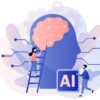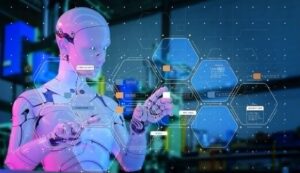AI platforms
Whether you realise it or not, there’s an AI tool for virtually every task you can imagine.
At the very least, AI can assist you in creating the tools you need to accomplish your goals.
Too good to be true? I thought so as well. With this in mind, I’ve explored 11 different AI platforms to help you discover the one that suits your needs best.
Let’s dive in!
What Should You Look for in an AI Platform?
Choosing an AI platform isn’t as simple as picking one off a shelf—it requires careful consideration to ensure the platform aligns with your goals and can be fully utilised. While testing AI platforms, I identified several key factors to help map their capabilities to specific objectives.
Here’s the summary:
Understand the Machine Learning Algorithm
Determine the type of machine learning algorithm the platform employs. It could be:- Supervised learning (where models are trained on labelled data),
- Unsupervised learning (working with unlabelled data to find patterns),
- Semi-supervised learning (a mix of the above), or
- Reinforcement learning (learning through trial and error to maximise rewards).
This choice impacts how the model evolves over time. Learn more about these algorithms on IBM’s ML guide.
Reduction of Manual Workload
Ensure the AI platform can automate repetitive tasks and reduce manual workloads, freeing you and your team to focus on more strategic activities. For tools focusing on automation, explore platforms like Zapier or UiPath.Human-Readable Outputs
Verify that the platform produces outputs understandable by humans, ensuring insights can be interpreted and applied effectively. Tools like Power BI and Tableau excel in this area by visualising AI-driven insights.Learning and Adaptation Time
Assess how long the platform takes to learn your working patterns and processes. A shorter adaptation period can lead to quicker, more accurate results. To experiment with adaptable models, consider tools like TensorFlow.Ease of Integration
Check the time and effort required to integrate the platform into your existing systems. Evaluate whether your business can afford the potential downtime. For seamless integration, platforms like Microsoft Azure AI or Google AI are worth considering.
The 15 Best AI Platforms
Here’s a detailed breakdown of the best AI-powered platforms I’ve tested, highlighting their features, limitations, pricing, and reviews to help you choose the one that best suits your needs.
1. ClickUp

- Best for: AI automation, data processing, and project management.
- Key Features:
- AI-Powered Task Automation: Automates repetitive tasks like assigning priorities and generating progress reports.
- Smart Project Management Tools: Includes Kanban boards, Gantt charts, and time tracking features.
- AI Writing Assistant: Helps with brainstorming, summarising notes, and drafting content.
- Customisable Dashboards: Allows you to tailor your workspace to your needs.
- Limitations:
- The interface can feel overwhelming due to its many features.
- Offline functionality is limited.
- Pricing:
- Free plan available. Paid plans start at $5 per user/month.
- Reviews:
- Praised for flexibility and robust automation features, though some users mention a steep learning curve.
- Learn More: Visit ClickUp.
2. OpenAI ChatGPT
Best for: Customer support, internal operations, and generative tasks.
OpenAI’s ChatGPT has gained widespread recognition in the AI industry for its exceptional generative capabilities.
I’ve found it invaluable for a variety of tasks, including writing assistance, brainstorming, idea generation, coding support, and data analysis.
One standout feature is the voice conversation option available on the mobile app. By tapping the headphone icon and wearing headphones, you can talk to ChatGPT, making interactions more dynamic and hands-free—ideal for multitasking.
Key Features
- Content Assistance: Quickly draft, edit, and refine written content.
- Translation: Translate text to multiple languages with ease.
- Coding Support: Generate code, debug issues, and learn programming concepts.
- Data Analysis: Identify patterns and trends in datasets faster than manual analysis.
- Voice Interaction: Communicate directly via voice in the mobile app for convenience.
Limitations
- Bias in Responses: As a large language model, outputs can sometimes reflect biases present in its training data.
- Generative Focus: Limited to content generation and specific tasks; not ideal for specialised operations like CRM management.
Pricing
- Free Plan: Limited features and slower response times.
- Plus Plan: $20/month per user (priority access and faster responses).
- Team Plan: $30/month per user.
- Enterprise Plan: Custom pricing; contact sales for details.
Ratings and Reviews
- G2: 4.7/5 (583 reviews).
- Capterra: 4.6/5 (57 reviews).
Learn More
Explore ChatGPT and its features on the OpenAI website.
3. TensorFlow

Best for: Natural Language Processing (NLP) applications, building complex machine learning models.
TensorFlow is a powerful end-to-end AI platform that provides a robust set of tools for creating and deploying machine learning models.
My team tested it to develop ML models that can run seamlessly in various environments. TensorFlow is especially beneficial when analysing relational data using graph neural networks.
Because of its extensive capabilities, TensorFlow is ideal for research and complex applications, such as building recommendation systems (for example, Netflix’s recommendation engine). It uses reinforcement learning models to optimise user experience and satisfaction.
Key Features
- Keras API: Makes it easier to build and train complex neural networks by providing a high-level interface.
- TensorBoard: A powerful visualisation tool to monitor and analyse the training process of machine learning models.
- XLA Compiler: Optimises TensorFlow graphs for faster execution on a range of hardware, including GPUs and TPUs.
- Advanced Research: Ideal for NLP applications, sentiment analysis, and recommendation systems.
Limitations
- Steeper Learning Curve: Compared to other platforms, TensorFlow can be more challenging for beginners.
- Resource-Intensive: TensorFlow requires high-performance GPUs or TPUs to function optimally, making it a resource-heavy platform.
Pricing
- Free: TensorFlow is open-source, so it’s free to download, install, and use.
Ratings and Reviews
- G2: 4.5/5 (60+ reviews).
- Capterra: 4.6/5 (100+ reviews).
Learn More
Explore TensorFlow’s capabilities on the TensorFlow website.
4. DataRobot
Best for: Building and deploying predictive models and custom AI applications.
DataRobot is an award-winning AI platform designed to simplify the development of data science and machine learning products. I tested it to build a predictive analytics model, and its specialisation in generative and predictive AI stood out as particularly beneficial for businesses. With its guided workflow, even non-technical users can navigate the entire model-building process with ease.
DataRobot is ideal for creating custom AI applications that integrate smoothly with existing systems. It streamlines business processes by offering intuitive tools for automation, optimisation, and seamless integration.
Key Features
- Algorithm Exploration: Automatically explores and tests various algorithms and hyperparameters to find the best-performing model for your task.
- Automation: Reduces manual work by automating time-consuming steps in model building, accelerating the development process.
- Model Transparency: Provides insights into how models make predictions, increasing trust and transparency.
- Integration Capabilities: Easily integrates with existing business systems and workflows.
Limitations
- Resource-Intensive: The platform requires significant computational resources, which may slow down systems.
- Dataset Limitations: Dataset size is capped at 100 GB for all combined and 11 GB per dataset, which can restrict larger projects.
Pricing
- Custom Pricing: Contact DataRobot for a tailored pricing plan based on your specific needs.
Ratings and Reviews
- G2: 4.4/5 (20+ reviews).
- Capterra: Not yet rated (fewer than 20 reviews).
Learn More
Discover more about DataRobot on their official website.
5. Microsoft Azure

Best for: AI-powered business solutions, including chatbots and virtual assistants.
Microsoft Azure is a cloud computing platform with robust AI integration, making it a standout for developing scalable and flexible AI-backed business solutions. I found it especially helpful for creating chatbots and virtual assistants thanks to its expansive toolkit and support for advanced AI models.
Azure offers a versatile collection of AI functionalities, enabling you to:
- Innovate with open and multimodal models.
- Use Retrieval Augmented Generation (RAG) for improved contextual development in bot interactions.
- Manage AI lifecycles with Large Language Models (LLMs) effectively.
Key Features
- Azure Machine Learning: Build, train, and deploy machine learning models easily.
- Azure Cognitive Services: Pre-built AI models for tasks like speech recognition, natural language processing, and computer vision.
- Azure Bot Service: Design, build, and deploy chatbots tailored to your business needs.
- Azure Data Lake Analytics: Analyze massive datasets seamlessly for data-driven decision-making.
Limitations
- Microsoft Ecosystem Dependency: Azure services are tightly integrated with the Microsoft ecosystem, which might limit cross-platform compatibility.
- Region-Specific Services: Some AI services are restricted to specific regions, which could impact businesses with global operations.
Pricing
- Custom Pricing: Azure offers tailored pricing depending on the services and usage levels. You can use the Azure Pricing Calculator to estimate costs.
Ratings and Reviews
- G2: 4.4/5 (2,000+ reviews).
- Capterra: 4.6/5 (1,500+ reviews).
6. Google Cloud AI

Best for: Integrating AI into existing applications.
Google Cloud AI is a robust cloud-based AI and machine learning platform offering a suite of pre-trained models for tasks like image recognition and natural language processing (NLP). I found it especially effective when paired with Vertex AI, which simplifies the configuration process, making it more accessible for those less familiar with technical setups.
This platform is perfect for quickly summarising lengthy documents, deploying AI-powered chat apps with Retrieval Augmented Generation (RAG), or building image-processing pipelines using preconfigured AI/ML modules.
Key Features
- AutoML: A collection of AI tools enabling you to create custom machine-learning models with minimal coding effort.
- Dialogflow: A powerful tool for building conversational interfaces, such as chatbots and virtual assistants.
- Vision AI: A comprehensive suite of APIs designed for image and video analysis, facial recognition, and similar use cases.
- Natural Language Tools: Process and analyse human language for sentiment analysis, summarisation, and more.
Limitations
- Vendor Lock-In: Being heavily integrated into the Google ecosystem, migrating away from the platform can be challenging.
Pricing
- Custom Pricing: Google Cloud AI offers flexible pricing based on your specific requirements. Check out the Google Cloud Pricing Calculator to estimate your costs.
Ratings and Reviews
- G2: Not available (fewer than 20 reviews).
- Capterra: Not available (fewer than 20 reviews).
Learn More
Discover how Google Cloud AI can support your business goals on the official website.
7. H2O.ai

Best for: On-premises deployment.
H2O.ai is an open-source, distributed machine learning platform tailored for big data management. It stands out for its ability to perform on-premises deployments, offering flexibility for organizations with strict data security or compliance requirements. I’ve used it to develop applications for image recognition, fraud detection, and other data-intensive tasks, leveraging its diverse algorithms such as deep learning, gradient boosting, and more.
With its latest Danube3-4B release, H2O.ai has enhanced its natural language processing (NLP) capabilities. Trained on 6 million tokens, it achieves up to 80% accuracy on benchmarks like 10-shot HellaSwag, making NLP more accessible to a wider audience.
Key Features
- Distributed Machine Learning: Scale efficiently across multiple machines, ideal for big data processing.
- In-Memory Computing: Enables faster processing and execution of machine learning algorithms.
- Automatic Feature Engineering: Automates complex tasks like handling missing values, creating interaction terms, and simplifying data preprocessing.
Limitations
- Complex Model Handling: Managing complex models can be challenging, especially for beginners.
- Scaling Limitations: Scaling to handle larger datasets sometimes introduces inefficiencies and complexities.
Pricing
- Custom Pricing: H2O.ai’s pricing is flexible and tailored to your needs. You can explore their offerings on the official H2O.ai pricing page.
Ratings and Reviews
- G2: 4.5/5 (20+ reviews).
- Capterra: Not available (fewer than 20 reviews).
Learn More
For more details on H2O.ai, visit the H2O.ai homepage.
9. IBM Watson Assistant (Best for self-service customer support)

IBM Watson Assistant is a conversational AI platform you can use to build gen AI assistants specifically for customer self-service stations. It can help you design natural and fluid chatbots for internal applications and front-end customer assistance.
The conversation builder has a drag-and-drop interface, which I consider crucial for defining user-friendliness for any AI platform. Additionally, the fact that this platform is augmented with RAG makes it that much more accurate and effective.
IBM Watson Assistant best features
- Use out-of-the-box LLMs, NLPs, NLUs (refer to this AI glossary to understand these terms), and Intelligent Context Gathering to improve contextual understanding of conversations
- Leverage RAG for accurate and updated conversations
- Customize model training that allows your business to use its own training data on IBM Watson Assistant models
IBM Watson Assistant limitations
- The performance of the assistant created using this platform is significantly impacted by the quality of training data
IBM Watson Assistant pricing
- Custom pricing
IBM Watson Assistant ratings and reviews
- G2: 4.4/5 (300+ reviews)
- Capterra: N/A (less than 20 reviews)
Learn More
For more details on H2O.ai, visit the IBM Watson Assistant
10. Amazon Sagemaker (Best for scaling large models)

Amazon Sagemaker is an AI platform with fully managed cloud infrastructure, workflows, and tools to make your work easier. It has helped me build, train, and easily deploy ML models for a variety of use cases like fraud detection and reinforcement learning.
What I like best about Amazon Sagemaker is that it provides support for governance requirements that simplify access controls and enhance transparency over your ML projects. This tool is quite handy for building your own foundation models and finetuning them.
Amazon Sagemaker best features
- Use no-code tools (for non-professionals) and IDEs (for data scientists) to work easily regardless of expertise
- Enhance auditability and transparency with MLOps practices and their standardization
- Build foundation models from scratch for additional revenue streams
Amazon Sagemaker limitations
- Even with the pay-as-you-go model, the costs can escalate quickly for large-scale projects
Amazon Sagemaker pricing
- Custom pricing
Amazon Sagemaker ratings and reviews
- G2: 4.2/5 (30+ reviews)
- Capterra: N/A (less than 20 reviews)
Learn More
For more details on H2O.ai, visit the Amazon Sagemaker
11. PyTorch (Best for R&D and computer vision)

PyTorch is a framework you can use to build deep learning models for applications like NLP. I have successfully used it to make image recognition apps and generative models using dynamic computation graphs.
As a production-ready platform, it lets you transition easily between immediate execution (Eager mode) and compiled execution (Graph mode) using TorchScript, which I think is quite efficient. Additionally, the platform uses a torch-distributed backend to scale and optimize the distributed training and performance.
PyTorch best features
- Make changes to network structure on the fly using Dynamic Computational Graph
- Speed up LLM training using the strong GPU support in PyTorch
- Leverage a rich library of pre-built deep learning modules to build solutions
- Get access to easy support through a robust community and extensive documentation
PyTorch limitations
- The dynamic computational graph has an inefficient memory management
- It has a steeper learning curve and takes time to understand and use
PyTorch pricing
- Custom pricing
PyTorch ratings and reviews
- G2: 4.6/5 (21 reviews)
- Capterra: N/A
Learn More
For more details on H2O.ai, visit the PyTorch
Conclusion
AI platforms are not merely tools of convenience; they are catalysts for progress, driving innovation across countless domains.
As they continue to evolve, these platforms hold the promise of enabling us to tackle challenges with greater precision and creativity, while opening new horizons of opportunity. Whether in business, education, or personal development, their capacity to “rewrite” the future is boundless.
By embracing these technologies responsibly and thoughtfully, we can harness their power to create a smarter, more connected, and sustainable world. The future of AI is unfolding, and it’s an exciting narrative to be part of.




















